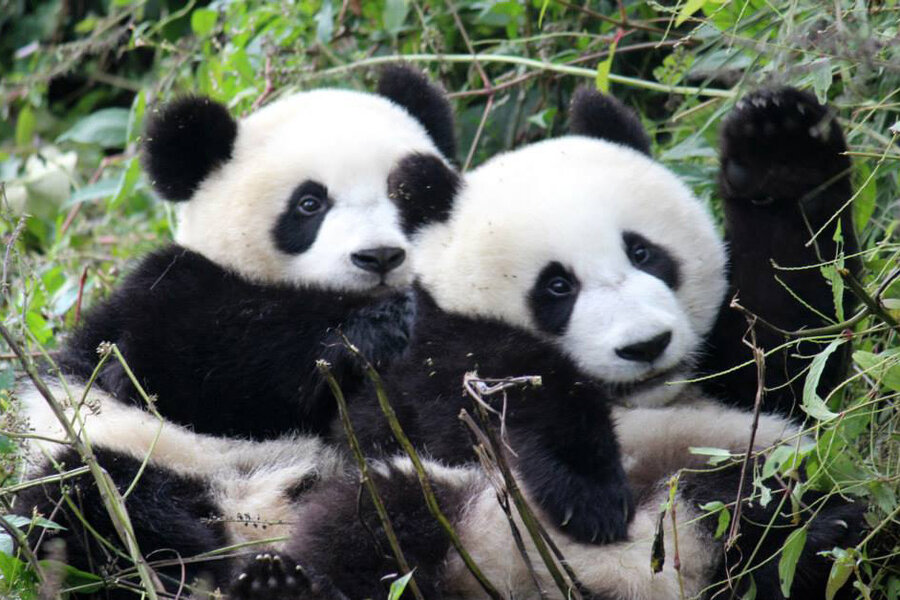To save the species, pandas need love, not just a mate
Loading...
Apparently, we’ve been going about coaxing pandas to mate all wrong. Enough with the matchmaking, they’re looking for love, a study says.
When pandas are allowed to be their own matchmakers, choosing between two prospective mates (with the help of extremely eager scientists), their "success" rate soared: pairs who were mutually attracted conceived a cub 80 percent of the time, whereas not a single pair selected by scientists for their genetic compatibility managed to conceive in the 40-bear study at a research center in Sichuan, China, whose results were published Wednesday in Nature Communications.
For breeding pairs in which just one partner showed a preference for their mate, the conception rate was 50 percent.
Giant pandas are notoriously difficult to breed, leading many programs to experiment with artificial insemination as conservationists race to save the species: despite years of research and millions, if not billions, of dollars poured into the original "charismatic megafauna," fewer than 2,000 survive in the wild, and attempts to release captive-born pandas back to nature have proved difficult.
Another 300 or so live in captivity, often deployed as "panda diplomats" to zoos around the world, who lease the bears for $1 million a year from China, where they must return once they reach four-years old.
"The future of conservation breeding will not take place in a test tube," the study's authors write. "Although remarkable advances have been made in human-assisted reproduction, the most cost-effective way to manage assurance populations and provide animals for reintroduction is to breed them naturally."
But the team thinks that a better understanding of pandas' mating preferences may help future conservationists restore the population more efficiently, saving money on a species whose high-maintenance diet and breeding have made many biologists question if they're worth saving at all.
It's not that pandas want to go extinct, despite a perceived reluctance to mate; they just want to have a say, even if only picking between two carefully-selected candidates, as they did in Sichuan, while scientists studied them for signs that someone piqued their interest. Romantically-inclined pandas tend to "chirp," or "bleat," and leave scent marks; ladies strut backwards, while gentlemen "performed a handstand against a vertical surface and urinated."
"Just as in humans, breeding signals are complicated," summarized lead author Meghan Martin-Wintle, of the San Diego Zoo Institute for Conservation Research.
"One of the myths that biologists are keenest to dispel is that pandas are bad at breeding," Sam Knight writes in his delightfully exhaustive "Everything you always wanted to know about panda sex (but were afraid to ask)." "You don’t survive for 7m years without knowing a thing or two."
But pandas do need all the help they can get. Females ovulate just once a year, and are really at a fertility peak for just 24 hours, a magic day that conservation biologists track and plan for obsessively. "The signs can be very subtle," Edinburgh Zoo head vet Simon Girling, Edinburgh zoo’s head vet, told Mr. Knight. "We are always worried that we are going to miss the window."
Offering pandas a choice of pre-vetted mates, rather than simply "introducing" two bears who scientists themselves would like to see together, might help panda-savers make the most use of that window. But other species with less challenging reproductive particularities could also benefit researchers' realization that they like to be in charge of their own romantic life.
According to the study's authors, underperforming breeding programs plague many species' survival efforts, from fish to other mammals. Mutual interest boosts not only conception rates, but offspring survival, and moms' feelings tend to have more significant impact than dads'.
Many scientists think it's time for real politik when it comes to Chinese pandas, arguing that the exorbitant costs of renting the bears, let alone breeding them, could be better spent elsewhere: saving their habitat, for instance, which would benefit a plethora of species sharing the space.
"It may well be that we can lose the cherries from the cake," naturalist Chris Packham told the Guardian in 2009, "but you don't want to lose the substance": bio-habitats themselves. He encourages biologists and donors to set their priorities based on facts, not cuddliness.
But if pandas' matchmaking could decrease the need for costly artificial inseminations, perhaps pandas can keep their role as conservationism's favorite poster child.
This report contains material from Reuters.









